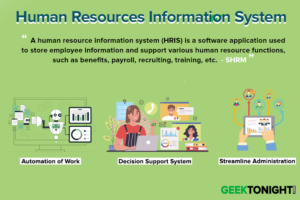What is Employee Grievance?
Employee Grievance means any type of disappointment or unhappiness arising out of factors related to an employee’s job which he thinks is unfair. A grievance can be factual, imaginary or disguised.
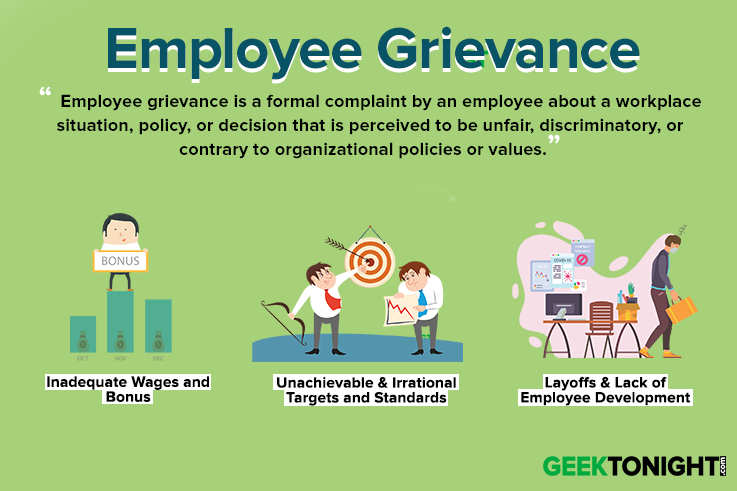
Table of Content
A grievance arises when an employee goes through an unfair, unjust or inequitable situation or treatment at the workplace. This feeling grows over a period of time and leads to a complaint by the aggrieved employee. And if his complaint goes unheard or unattended for a long time it takes the form of grievance.
A well-defined grievance procedure is an important element of sound industrial relation machinery. To maintain industrial peace prompt actions should be taken and the grievance of the employees should be effectively attended to.
Employee Grievance Definition
Dale S Bearch defines it as, “A grievance is any dissatisfaction or feeling of injustice in connection with one’s employment situation that is brought to the attention of management“.
According to Michael J Judicious, “A grievance is any discontent or dissatisfaction whether expressed or not, whether valid or not, arising out of anything connected with the company that an employee thinks believes or even feels, is unfair, unjust or inequitable“.
The Society for Human Resource Management (SHRM) defines an employee grievance as an employee’s formal or informal complaint to a supervisor, manager, or human resources representative about a workplace situation that is perceived to be unfair, unjust, or inequitable.
The International Labour Organization (ILO) defines a grievance as a complaint or dispute by an employee, group of employees, or trade union, relating to wages, hours of work, conditions of employment, or other work-related matters.
Causes of Grievance
There are various factors that leave an employee unhappy and dissatisfied at the workplace. They become a cause of concern and results in a demotivated staff. Below are some of the causes of grievance:
- Inadequate Wages and Bonus
- Unachievable and Irrational Targets and Standards
- Bad Working Conditions
- Inadequate Health and Safety Sevices
- Strained Relationship Amongst the Employees
- Layoffs and Retrenchment
- Lack of Career Planning and Employee Development Plan
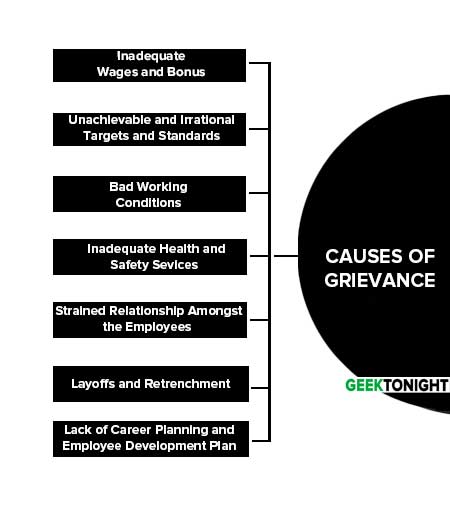
Inadequate Wages and Bonus
When the workers are not paid an adequate amount of wages and bonuses for their hard work or if equal wages are not paid for the same work, the grievance may arise.
Unachievable and Irrational Targets and Standards
Sometimes targets set by the managers are so impractical, that they cannot be achieved easily. Workers eventually get under tremendous stress and pressure in the effort of chasing the targets, which leads to grievance among the employees.
Bad Working Conditions
Working conditions is a very important factor that impacts the satisfaction level of an employee. Bad working conditions, unavailability of tools and proper machinery etc lead to grievances amongst the employees.
Inadequate Health and Safety Sevices
Companies while paying attention to maximizing their profit end up compromising the health and safety conditions of the employees. An unhygienic environment, poor safety conditions etc demotivate an employee to come to the workplace.
Strained Relationship Amongst the Employees
Sometimes the employee feels jealous, anxious, nervous etc. working with their employees, superior or subordinate. The absence of healthy relationships amongst the employees leads to an environment which is conducive to unhappiness, dissatisfaction and grievance.
Layoffs and Retrenchment
At the time of economic breakdown, every company try to reduce the strength of their employees so that they can cut down the overall cost. In such cases, the retrenched employees feel cheated and it also instils fear in the minds of the employees who are retained.
Lack of Career Planning and Employee Development Plan
Planning enables employees to think about their future and overall development. For the employees to stay successful in their career it is a must for them to keep pace with the changing trend and environment. Lack of planning and showing no interest in the development of an employee makes them dissatisfied and stagnant in life.
Effects of Grievance
A dissatisfied and unhappy employee will not be able to perform to the best of his ability. His mind will be preoccupied with the things that are bothering him which leads to a lack of focus on his current job in hand. It leads to a drop in productivity and efficiency of the employee and the organization as a whole.
Below are some of the effects of employee grievance:
- Demotivated Staff
- Low Productivity
- Labor Unrest
- Absenteeism
- High Rate of Attrition
- Strains the Superior-Subordinate Relationships
- Reduces Employee Morale and Commitment
- Increase in Wastage and Cost
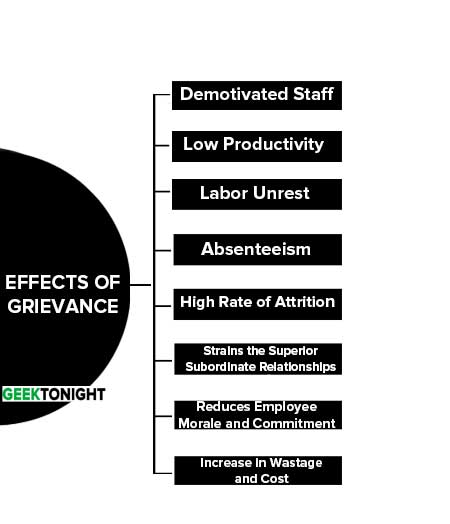
Demotivated Staff
If there is no corrective action taken when an employee approaches with a complaint regarding something that is troubling him at the workplace, he may end up feeling frustrated and demotivated. A demotivated employee losses his interest in his work or job assigned. He works only for the sake of wages or salaries.
Low Productivity
If the grievance is not sought out in proper time or as and when it arises employees become dissatisfied and will not work to their full potential which leads to low productivity overall.
Labor Unrest
Distressed employees if not handled properly eventually can even get violent which will cause heavy damage to the company.
Absenteeism
Delay or neglect in solving the problem of the employee will kill the drive in him to report to work every day This may cause an unwanted increase in absence rate.
High Rate of Attrition
Attrition rate refers to the number of people leaving an organization over a period of time. If an employee is unhappy with the organizations working conditions, culture etc, the organization may end up eventually losing the employee to its competitors in the industry.
Strains the Superior-Subordinate Relationships
Once disciplinary action is taken against a subordinate it strains the relationship between the superior and him as he feels that the action must be taken as per superiors’ recommendation or with his consent and knowledge.
Reduces Employee Morale and Commitment
An unattended grievance of an employee may make him feel that he is been taken for granted by the organization. His morale and faith in the organization may come down tremendously and he may not feel committed to the organization anymore.
Increase in Wastage and Cost
With an occupied mind the employee may not be able to focus in utilizing the factors of production to the optimum level, this might lead to wastage of materials and lead to high costs.
Grievance Handling Procedure
The effectiveness of a grievance procedure depends on some prerequisites which are as follows:
- Acknowledging Grievance
- Quick Action
- Adherence to Prevailing Law
- Clarity
- Grievance Handling Training should be given to Senior
- Execution and review (follow up)
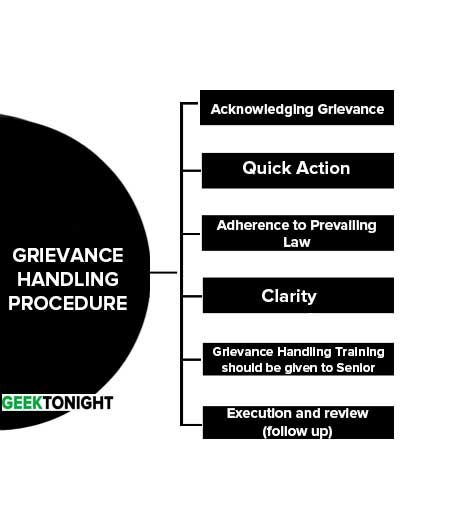
Acknowledging Grievance
Any kind of discontent or dissatisfaction whether expressed or not, whether valid or not, should be entertained by the superiors and managers, there should be a free flow of communications and the employees should feel free to express whatever is troubling them.
Acknowledgement of their problems instills confidence in them that they are in safe hands and their problems will be resolved.
Quick Action
As we all know justice delayed is justice denied. A grievance should be settled at the lowest stage, it will ensure the worker that management is listening to them and trying to solve their problems. The grievance procedure must aim at a speedy settlement of a grievance.
Adherence to Prevailing Law
The grievance procedure should be planned in compliance with the existing law. In other words, the existing grievance machinery as provided by law should be strictly followed.
Clarity
The procedure should be clear and simple enough to be understood by each and every employee. Every employee must clearly understand the different stages of the procedure, the forms to be filled up etc.
Grievance Handling Training should be given to Senior
Training should be imparted to the supervisors and union representatives because they are the one, who guide, supervise or spend more time with workers at the workplace.
So if any grievances arise it will instantly come to their knowledge, it is most effective if the grievances are resolved at that stage itself, there will be no need of taking it further to the next level.
Execution and review (follow up)
A regular follow up of the system increases the faith of the people in the system. The HR department should periodically review the grievance procedure of an organization and make the necessary changes whenever required.
Steps in Grievance Handling
Grievance affects not only the employee and the manager but also the organization as a whole. The grievance procedure has to be carefully designed and implemented as it deals with human sentiments.
Below steps should be followed to redress the grievance for the smooth functioning of the organization.
- Acknowledge and understand grievance
- Gathering facts and data
- Analysis of the grievance
- Deriving a solution
- Redressal
- Execution and Follow up
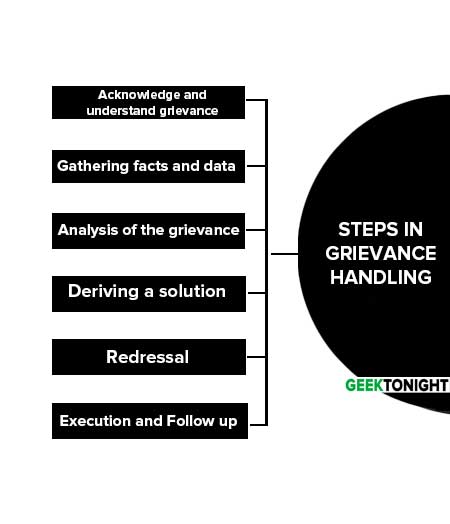
Acknowledge and understand grievance
The first step in grievance handling is to timely acknowledge the problems before they turn into actual grievances through several means such as:
- Observation: Through observation, a manager/supervisor can easily track the behaviour of people working under him. He can easily find out the unusual behaviour and prepare report accordingly.
- Opinion surveys: Periodical interviews, group meetings, collective bargaining sessions etc with the workers are also helpful in knowing employee discontent before it becomes a grievance.
- Gripe boxes: It is a box in which employees can drop their complaints. Employees do not have to disclose their identity while expressing their feelings of injustice or discontent.
- Exit interviews: Employees usually leave their current jobs due to dissatisfaction regarding some areas at work. Exit interviews, conducted properly, can provide important information about employee’s grievances.
- Open door policy: This policy is useful in keeping touch with the employee’s feelings as some organizations extend a general invitation to their employees to talk over their grievances in the manager’s room.
Gathering facts and data
The next step is to collect facts and data about the grievance from all the parties involved. Everyone’s opinion should be given equal importance and no fact should be neglected or ignored
Analysis of the grievance
The problem should be analyzed on the basis of the facts and data received after taking into consideration the economic, social, psychological and legal issues involved in them.
Deriving a solution
After analyzing all the facts and data, different alternative solutions to the problem should be discussed and the best solution should be selected.
Redressal
The grievance should be redressed by promptly putting into action the best solution selected. The employee should be relieved of the stress and discontent as soon as possible.
Execution and Follow up
Once the solution is executed and implemented, there should be a timely follow up registering the employee’s reaction to the decision. Also, it should be checked time and again whether the issue has been properly closed and it should be made sure that it does not reoccur.
Benefits of Grievance Handling
The benefits of a good grievance handling system are as follows:
- Avoids Disputes
- Opportunity for the Workers to Express their Dissatisfaction
- Boosts Morale and Emotional Security
- Enhances Commitment of the Staff
- Helps Maintain Cordial Relationship
- Improves Staff Productivity
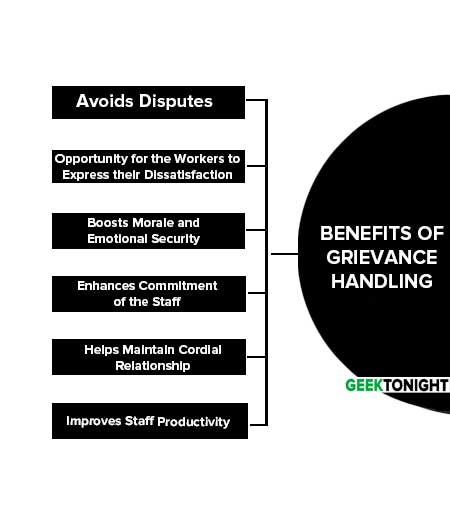
Avoids Disputes
Before a grievance takes the form of any kind of dispute, it is the duty of the management to solve it as soon as possible. Timely redressal of grievance saves the organization from settling a dispute that may arise otherwise.
Opportunity for the Workers to Express their Dissatisfaction
It provides the workers an opportunity to express their fears, anxieties and dissatisfaction. It brings grievance to the open and to the knowledge of the managers so that they can take a step to resolve it.
Boosts Morale and Emotional Security
It provides employees a platform where they can formally release their emotional stress and dissatisfaction. It thus builds within him a sense of emotional security.
Enhances Commitment of the Staff
When the employees feel emotionally secured that their problems and grievances are being attended to and resolved promptly, they feel a sense of commitment to the organization. Their drive to perform to the best of their ability increases and they become more loyal towards the organization.
Helps Maintain Cordial Relationship
Acknowledgement of employee grievance by the managers and redressal of the same as soon as possible promotes a healthy relationship between the subordinate and the superior. The subordinate feels cared for and in return would follow the instructions of the superior with greater dedication.
Improves Staff Productivity
When an employee grievance is attended to and a prompt action is taken to redress it, it boosts the employee’s morale, motivates him to maximize his potential and work with full dedication and commitment. This results in higher standards of productivity and optimum utilization of resources.
Labour Laws to Deal with Grievances in Indian Context
Indian Governmentratified Article 1 of the Convention 122 of the International Labour Organization in 1998. According to Article 1 of the Convention, it can thus be concluded confers upon workers the right to have redressal mechanisms to their grievances and thus the Indian Government has ratified Article 1 of the Convention 122 obligated to look into such interests if the workers. The government of India had initiated few laws which partially focus on the mechanism or aspect of an employee grievance. Such act as follows;
- The Industrial Employment (Standing Orders) Act, 1946
- The Industrial Disputes Act, 1947
- The Factories Act, 1948
- The Sexual Harassment at The Workplace (Prevention, Prohibition and Redressal) Act 2013
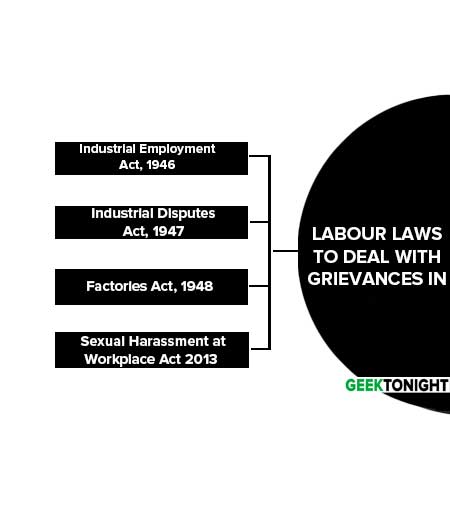
The Industrial Employment (Standing Orders) Act, 1946
According to this act that every industrial establishment wherein one hundred or more workers are employed or were employed on any day of the preceding 12 months should frame standing orders, which should contain a provision for the redressal of grievances of workers against unfair treatment and wrongful actions by the employer or the supervisor at that establishment.
Model Grievance Procedure was adopted by the Indian Labour Conference in 1958 and presently the Indian industries are adopting either the Model Grievance Procedure or procedures formulated by themselves within the guidelines of the act.
The Industrial Disputes Act, 1947
The act was amended in 1965 which provides for the redressal of individual disputes relating to discharge, dismissal or retrenchment. Amendment Act 1982 has made provision for the install of a grievance settlement committee. Any employer of any industrial undertaking employing 50 or more workers is required to provide for a grievance settlement authority for settlement of industrial dispute connected with an individual worker.
Two most important aspect of the act is Section 2A and 11A. This act has provided various dispute settlement machineries such as Works committee, Conciliationofficer, Board of a conciliation officer, Courts of Inquiry, Labour Courts, Tribunals and National Tribunals
The Factories Act, 1948
Workplace condition is a major source of an employee grievance. Therefore Government of India made provision of welfare officers as well as a safety officer under the factories act. This act mandates the appointment of a WelfareOfficer in every factory ordinarily employing five hundred or more workers.
The Sexual Harassment at The Workplace (Prevention, Prohibition and Redressal) Act 2013
Sexual harassment of women at the workplace is another source of grievance among female employees. Therefore Government of India initiated this act. It stated that any aggrieved woman may make, in writing, a complaint of sexual harassment at the workplace to the Internal Committee if so constituted, or the local Committee, in case it is not so constituted, within a period of three months from the date of incident and in case of a series of incidents, within a period of three months from the date of last incident.
Emerging Area of Employee Grievance
A grievance can be because of wage and salary, working hours, condition of work premises, employment conditions. Following are some emerging factors of grievance as a whole;
- Weakness and failure of Trade Union
- Sexual Harassments in the Work Place
- Unorganized Employment Sector
- Contract labour issues
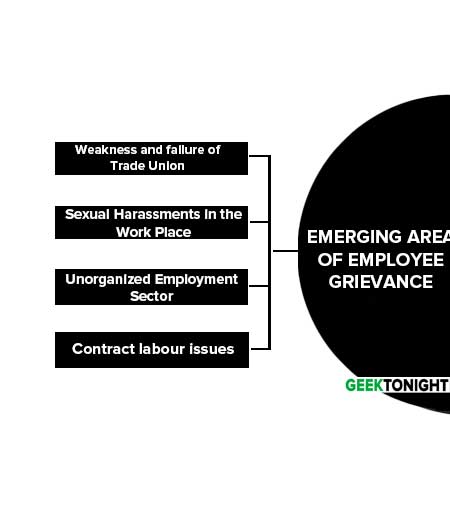
Weakness and failure of Trade Union
Because of easiness to form a trade union, multiples unions exist in one industry and among unions, differences use to start relating to various issues and not able to solve their grievance. The politicization of trade unions is also one of the reasons for becoming weakness and failure to function properly on behalf of employees’ grievance redressal.
Sexual Harassments in the Work Place
Though the Government of India has passed the Sexual Harassment of Women at Workplace (Prevention, Prohibition and Redressal) Act, 2013 but still implementation and effectiveness of this act is a big question. Day by day incidents of sexual harassment cases are rising in the workplace. If it continues like this Indian industry will face a gradual decline of the women work force.
Unorganized Employment Sector
In the unorganized sector, no concern about healthy working conditions, job security, career growth, leaves and paid holidays. The workers have lower protection against unfair or illegal practices and in every means maximum labour exploitations are there. Govt. of India enacted an act on the Unorganized Workers’ Social Security Act 2008 for providing social security and welfare of the unorganized workers. But in practically speaking, workers of the unorganized are being exploited continuously so if grievance of employees in this sector is not redressed it may bring industrial unrest in future.
Contract labour issues
In a globalized and knowledge economy dependence on contracts, labour are increasing drastically. There are not that many amendments in the Contract Labour (Regulation and Abolition)act 1970, which could really cover all the dynamism of Contract Labour issues. Recently in India, more protests and labour unrest took place due to contract labour issues.
In maximum cases contract, labours are getting exploited by employers. So there should be proper mechanisms and guidelines which must be followed and implemented in ground reality to redress and manage employee grievances of contract labour.
Human Resources Tutorial
(Click on Topic to Read)




